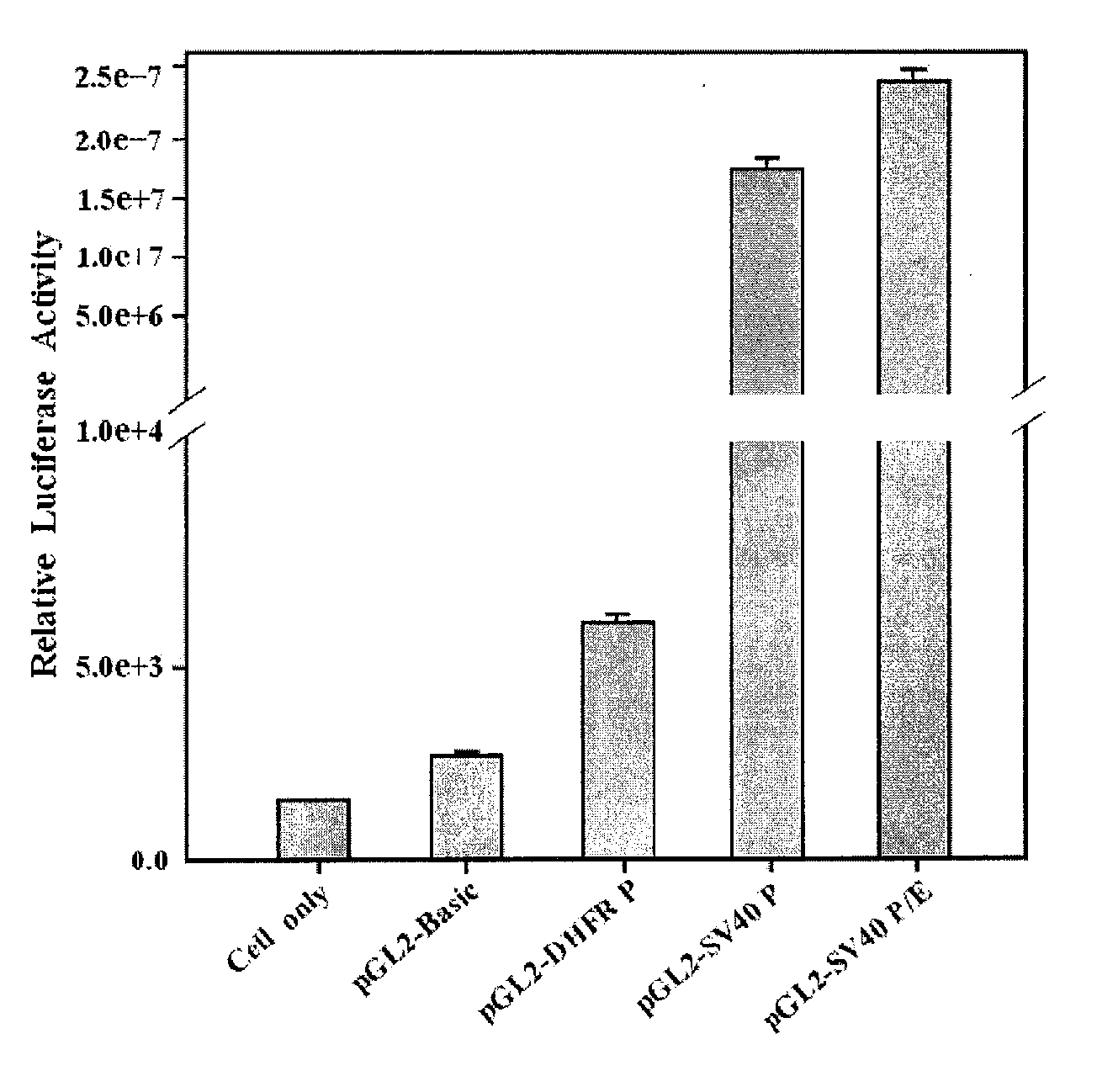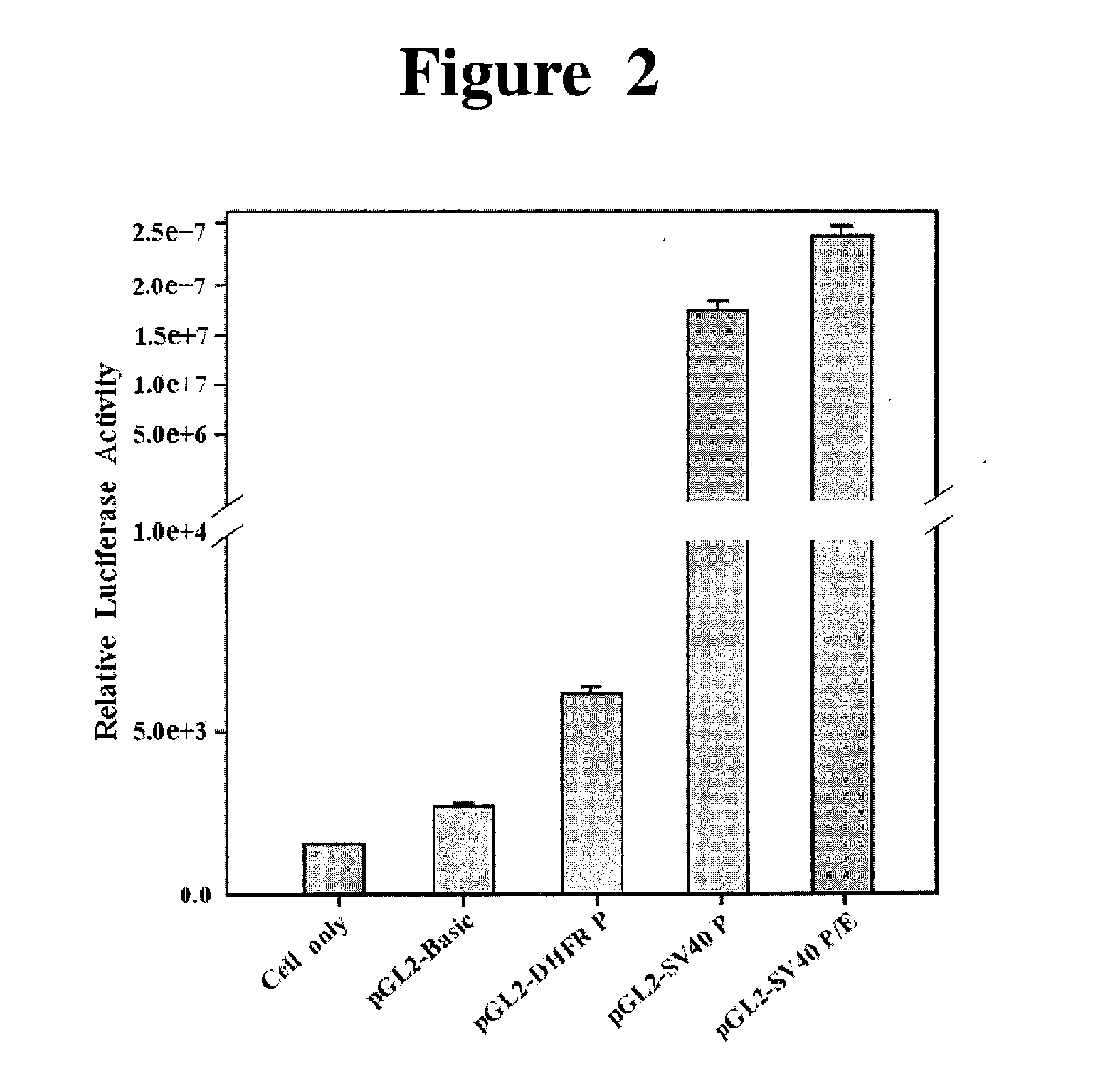Recombinant Expression Vector for Animal Cell
a technology of recombinant expression and animal cells, applied in the field of recombinant expression vectors for animal cells, can solve the problems of reduced cell growth rate and productivity, low level of transfected foreign gene expression of animal cells,
- Summary
- Abstract
- Description
- Claims
- Application Information
AI Technical Summary
Benefits of technology
Problems solved by technology
Method used
Image
Examples
example 1
Cloning of Mouse Derived DHFR Promoter, SV40 Early Promoter and SV40 Virus Early Promoter and Enhancer
[0057]The polymerase chain reaction (PCR) was performed as follows.
[0058]First, mouse genomic DNA was isolated using DNA extraction kit (Intron, Korea) ID obtain the DHFR promoter region which is included in the 5′-end sequence of DFHR gene and has strong TATA sequence and basic promoter activity. The mouse derived DHFR promoter was amplified by PCR using 200 ng of isolated mouse DNA, 50 pmol of P1 and P2 primers, 0.5 mM of dNTP and Softmax DNA polymerase (Intron, Korea). The PCR cycle was 29 cycles of denaturation at 1 min at 95° C., 40 sec at 50° C. and 40 sec at 72° C. followed by 10 min at 72° C.
[0059]The DNA fragments of early promoter and promoter / enhancer (enhancer operatively linked to the promoter) were amplified by PCR using 10 ng of pcDNA3 vector (Invitrogen, USA) as the template and either P3, P4 and P3, P5 primer sets, respectively. The PCR method (temperature, time and...
example 2
Comparing the Promoter Activity by Measuring the Expression Level of Luciferase Gene Transcriptionally Regulated by pGL2-DHFR, SV40 Promoter and SV40 Promoter / Enhancer
1) Gene Transfection
[0061]COS7 cells (ATCC, USA) were plated in DMEM (Dulbecco's Modified Eagle Medium; GIBCO BRL, USA) supplemented with 10% fetal bovine serum and subcultured in a 37° C., 5% CO2 incubator. The cells were plated at a density of 1×106 cells / ml in a 100 mm culture plate and incubated overnight at 37° C., before washing 3 times with OPTI-MEM (osteogenic media I; GIBCO BRL, USA) solution. Meanwhile, 5 μg of pGL2-Basic, pGL2-DHFR, pGL2-SV40P (Promoter) and pGL2-SV40 P / E (Promoter / Enhancer) prepared were each diluted in 500 μl of OPTI-MEM I. Twenty five μl of lipofectamine (GIBCO BRL, USA) was also diluted in 500 μl of OPTI-MEM I. The expression vector and the diluted lipofectamine solution was mixed in a 15-ml tube and incubate at room temperature for 15 min or longer to allow DNA-lipofectamine complex to ...
example 3
Construction of pJK-DHFR-1 Vector
[0064]Human genomic DNA was isolated from human blood using DNA extraction kit (Intron, Korea) to clone the DHFR gene. DHFR gene was amplified by PCR using the purified human genomic DNA as a template.
[0065]The polymerase chain reaction (PCR) was performed as follows. First, DHFR gene was amplified by PCR using 200 ng of isolated human genomic DNA as the template, 50 pmol of P6 and P7 primers, 0.5 mM of dNTP and Softmax DNA polymerase (Intron, Korea). The PCR cycle was 29 cycles of denaturation at 1 min at 95° C., 40 sec at 55° C. and 40 sec at 72° C. followed by 10 min at 72° C., resulting in amplification of 1462 bp DHFR gene. Mouse DFHR basic promoter was amplified by PCR using pGL2-DFHR as the template and P8 and P9 primer pair, following the PCR method (temperature, time and cycle) similar as described above.
[0066]The 3′-region of amplified DHFR basic promoter and the 5′-region of DHFR gene both has conserved 19 bp base sequence region. This con...
PUM
 Login to View More
Login to View More Abstract
Description
Claims
Application Information
 Login to View More
Login to View More - R&D
- Intellectual Property
- Life Sciences
- Materials
- Tech Scout
- Unparalleled Data Quality
- Higher Quality Content
- 60% Fewer Hallucinations
Browse by: Latest US Patents, China's latest patents, Technical Efficacy Thesaurus, Application Domain, Technology Topic, Popular Technical Reports.
© 2025 PatSnap. All rights reserved.Legal|Privacy policy|Modern Slavery Act Transparency Statement|Sitemap|About US| Contact US: help@patsnap.com



